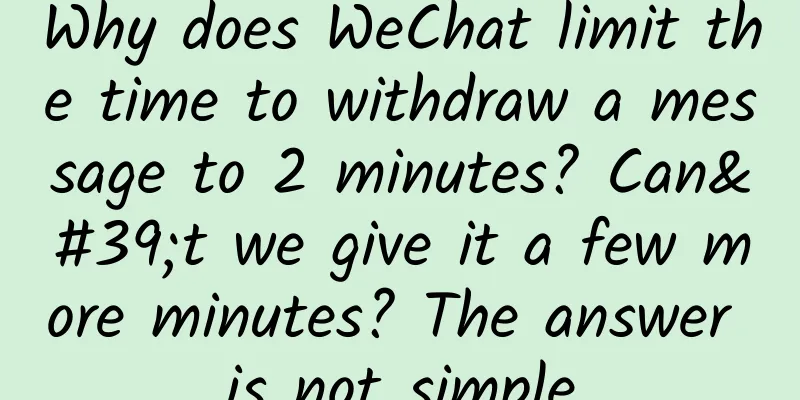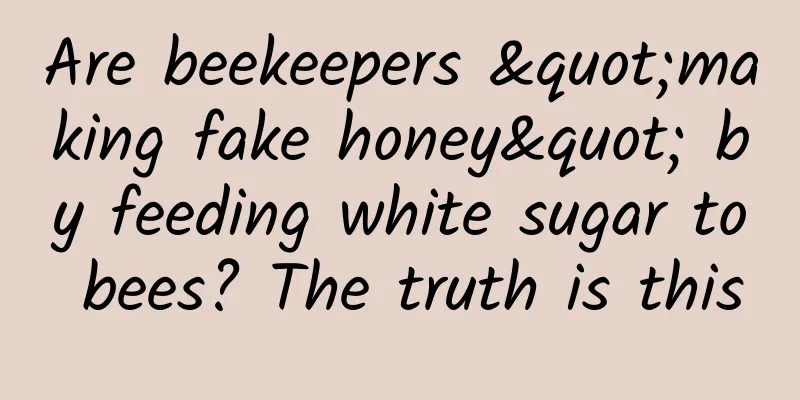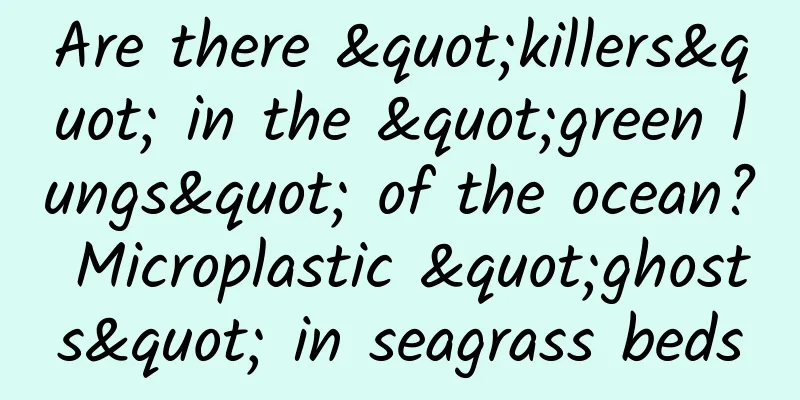Why does WeChat limit the time to withdraw a message to 2 minutes? Can't we give it a few more minutes? The answer is not simple

|
As the ancients said, "Once a word is spoken, it cannot be taken back." This shows how much importance is attached to what is said. However, people always say the wrong thing sometimes. To solve this problem, WeChat has a "withdraw" function, which provides a withdrawal option for messages sent within 2 minutes: So here comes the question… Why can a sent message be easily withdrawn? How does WeChat achieve the withdrawal of information from both parties’ phones at the same time? Take Mobile A sending a message to Mobile B and withdrawing the message as an example: When A.Mobile A sends a message, it will generate a globally unique UniqueMsgID on its own WeChat client and attach the UniqueMsgID to the message body to be sent. B. When Mobile B receives the message, it stores the message body and displays the message. C. When Mobile A withdraws a message, Mobile A knows the UniqueMsgID of each message body it has sent. If it needs to withdraw a message, it will attach the UniqueMsgID of that message to the withdraw command. D. When Mobile B receives the withdrawal command, it searches for the corresponding message body in its own database based on the UniqueMsgID in the withdrawal command, and then displays the withdrawal effect. Why does it only take 2 minutes to withdraw a message on WeChat? The mobile Internet era has forced everyone into an era of asynchronous information processing. Most people will wait a while before processing messages. In comparison, two minutes seems a bit too short. People often encounter the dilemma of wanting to withdraw a message only to find that the validity period has expired. So, do we need to set a withdrawal deadline? The answer is undoubtedly yes. If you do not set a withdrawal time in a two-way dialogue, two hazards will occur: A. If you do not set a withdrawal time after sending a message, it is very likely that the recipient has already seen the message, and the sender withdrawing the message will make the relationship between the two parties more awkward, and even cause unnecessary misunderstandings. B. After a message is sent, if the withdrawal time is unlimited, the sender can withdraw any historical message, which will result in incomplete conversation context and affect the user experience. So why is the withdrawal time 2 minutes? Can't it be more or less? In this regard, the WeChat product team conducted a big data analysis and concluded that from the perspective of the information receiver, 2 minutes is the average time from receiving to reading a message. If the withdrawal time is within 2 minutes, the context will be kept intact to the greatest extent possible, giving people a stable user experience. If it is shorter than 2 minutes, the person who posted the information may not realize the error in the information and may have missed the opportunity to withdraw it. If it is longer than 2 minutes, the probability of the message being read by the recipient is greatly increased, and the sender will no longer need to withdraw it. In addition, withdrawing a message sent a long time ago will also destroy the context coherence, seriously affecting the conversation experience and effect. Instead of setting a time limit, why not remind the other party that the message has been read in the withdraw function? Although 2 minutes is the average time from receiving to reading a message, we have no way of knowing when the recipient will actually read the message. This can cause the recall function to not be timely at times, leading to the famous "Schrödinger's cat" problem. So why doesn't WeChat provide a message reminder in the recall function that the message has been read? This way, the sender can choose whether to recall the message according to the situation. If there is a reading prompt function, the receiver will know that the sender already knows that he has seen the message that the other party wants to withdraw, which will make both parties more embarrassed.
Internet pictures More often than not, the receiver does not want the sender to know whether he or she has read the message. For example, in a common employee-boss group, after the boss sends a message, if he or she finds that the employee has read the message but did not reply (for example, because the employee is on a date), then over time, the boss will inevitably become dissatisfied with the employee. But if there is no prompt for read or unread messages, the boss will not know whether the employees are online, and the employees will not have to keep an eye on their phones all the time. The product philosophy behind these settings is that WeChat does not want to put pressure on the recipient of the message. Compared with the sender and the receiver, WeChat pays more attention to the receiver's experience. Why does a text prompt appear when withdrawing a message on WeChat? Since withdrawing information provides users with a way to regret, why do they still leave a reminder that "someone withdrew a message" after taking it? The answer is that if the receiver receives a notification but finds no message after opening it, he or she will think the message is lost and ask the sender to resend it, which will make both parties more embarrassed. In addition, in some specific situations such as business negotiations or loans, if there is no text prompt when withdrawing the information, it will cause the other party to suffer losses. For example, the borrowing problem mentioned by Zhihu netizens: From the perspective of function development, the creation of the recall function is to take into account normal usage scenarios such as typos or sending to the wrong person. For those special scenarios, users should try to control their emotions before sending the message and avoid "acting impulsively". Therefore, WeChat sets up a text withdrawal reminder, which not only leaves a hint of imagination for the recipient, but also reminds those users who "love to withdraw" that instead of over-abusing the function, they should dare to be responsible for what they say. |
<<: How to quickly transfer data between iOS devices? One trick can help you do it
>>: Android-side permission privacy compliance practices
Recommend
One picture to understand | Let's understand the true meaning of Webb's first batch of "space photos"
In July this year, the James Webb Space Telescope...
Nanjing Hearthstone CEO Zhu Wei: Mobile game development can also be "unconventional"
In early 2015, Newzoo, a game industry research o...
How does the Southern Xinjiang Loop Railway encircle my country's largest desert?
Recently, the Hotan-Ruoqiang Railway in Xinjiang ...
I am a terrifying snake, but I am about to become a meal! | Expo Daily
Snake, I'm about to become a meal Environment...
Is it true that chicks can be hatched without a shell?
Yesterday, I talked to you about "How to cra...
Using smart devices to keep you safe? Beware of being fooled by superficial information
Usually, new products and technologies emerge wit...
In-depth understanding of the Android graphics system
1. Introduction to Graphics System The graphics s...
7 days after the mini program was launched, Luo Pang ran away with 10 million users...
Before January 9, Zhang Xiaolong’s several rounds...
How to write a good advertising case analysis? Three simple steps to tell you
During the holidays, a reader asked me a question...
How to make Kuaishou’s live streaming GMV exceed 10 million?
In 3 months, the number of simultaneous online us...
How much does it cost to customize the Yancheng rain gear app? Yancheng rain gear applet customization price inquiry
WeChat Mini Program is an application that users ...
After Douyin defeats Kuaishou, how long will it remain popular among users?
Some time ago, a strange wind suddenly blew up in...
Breast cancer, hepatitis, ovarian cancer... Is hair dyeing responsible for so many problems?
People often say that dyeing your hair frequently...
Farewell, FLASH! You and I have walked through the era
[[158144]] The Flash era is over! This message fl...









